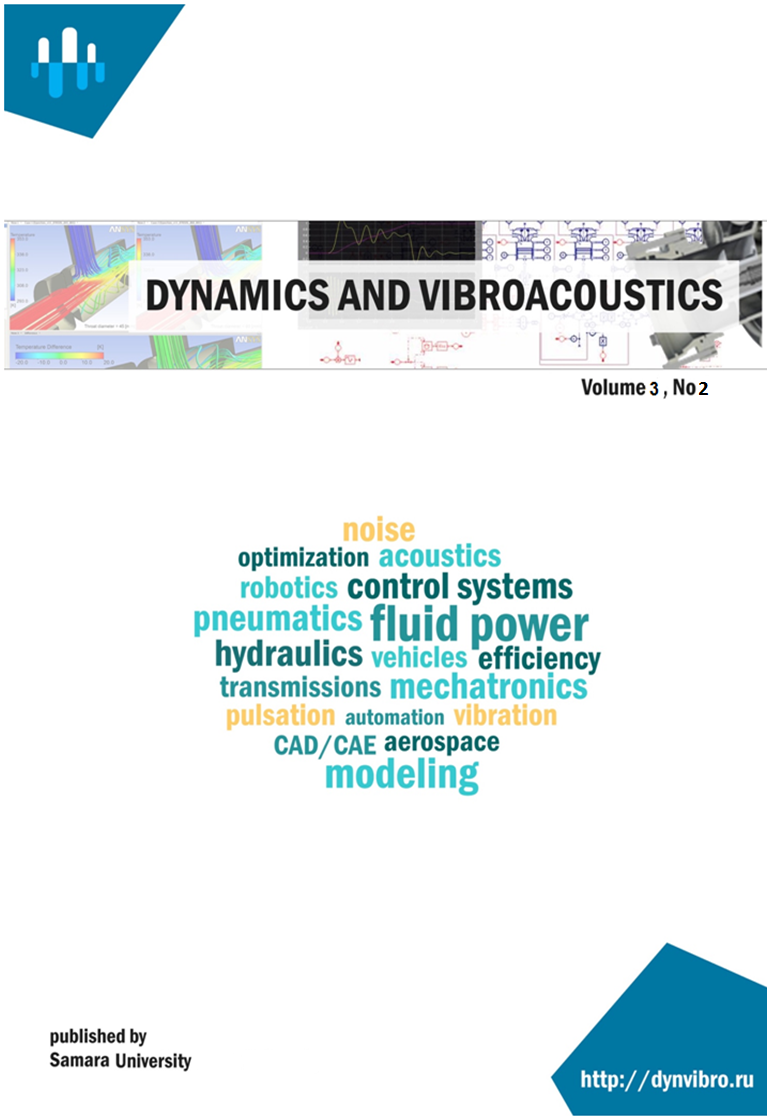Vol 3, No 2 (2016)
Articles
Double long-wavelength speckle interferometer for gas-turbine engine parts vibration research
Abstract
To investigate gas-turbine engine parts vibration speckle interferometer has been developed, an optical scheme of which includes two sources of laser radiation with different wave length. This has made it possible to increase vibration measurement accuracy due to experimental points number increase. A diagram of the 7-th stage compressor blade inlet edge vibratory displacements has been plotted according to the second flexural mode using speckle interferograms obtained at different length of the applied laser radiation.
 6-11
6-11


The study on muffler parameters influence on the pneumatic pressure reducing valve performance
Abstract
The main noise source in gas distribution systems is the gas pressure reduction in regulators. Nowadays the special mufflers, representing a set of orifices, are widely used for pressure regulator noise reduction. However, the installation of such devices may cause malfunction of the unit. That is why there is a need to study the characteristics of regulator with the muffler in order to select the parameters at which the desired pressure reduction is retained and the noise is reduced.
This paper studies the regulator which represents an equivalent of reduction valve of a similar scheme with the muffler installed in the outlet line. The output impedance increase may lead to loss of stability and control accuracy. The mathematical model of this system was implemented in the Simulink software in order to analyze the muffler impact on pressure relief valve static and dynamic characteristics. The program in Matlab software was also developed for determination of the noise generated by the system. The experimental research using the pneumatic bench was carried out for mathematical model verification.
The dependences between the main system operating parameters and the muffler flow area were obtained as a result of simulation. The muffler influence on the transient processes quality was analyzed. The areas of stability in the regulator and muffler parameter space were calculated. The muffler flow area values, providing the lowest level of the noise generated by the system were determined. The theoretical results have good correlation with experimental data.
 12-20
12-20


Vortex pulsation simulation of a piping noise dampener
Abstract
This paper presents a research on dynamic characteristics of an internal pipe noise dampener. The study covers an investigation of vortex pulsations within a pipe system after the dampener. For this purpose, the numerical technique of estimation of hydrodynamic noise after the dampener diffuser has been developed. This technique is based on LES turbulence model. The obtained numerical data illustrates the inherent hydrodynamic noise level in the dampener diffuser. This noise level allows us to estimate background noise condition of the piping in which dampeners are used. The numerical results are verified by experimental data which confirm the adequacy of the developed model at the low frequency range.
 21-32
21-32


Development methodology for a pulsation damper of gas control valves
Abstract
The background for the proposed methodology is based on the principle of stage throttling with simultaneous equalizing and stabilizing the outflow, as well as elimination of gas-dynamic self-oscillating modes of the control valve. Having conducted an analysis of suppression and dampening means and according to established patterns of occurrence of self-oscillations we have suggested an integrated pulsations damper performing the following functions: elimination of gas-dynamic self-oscillations, reducing pressure pulsations in the source by reducing pressure drop, stage throttling with a reduced flow rate and outflow stabilization. A distinctive feature of our methodology is combining experimental dependencies with numerical simulation of natural modes and gas-dynamic processes taking place in the control valve and pressure pulsation damper. As initial data for designing the damper we have set its desired efficiency while ensuring specified operating modes of the gas distribution station and specified restrictions on dimensions and hydraulic resistance. The methodology allows for a significant reduction of broadband pressure pulsations and vibration by the damper due to the rational and maximum permissible distribution of pressure differences in the control valve and damper under operating conditions in which the total vibrational power of the control valve and damper is maintained close to the minimum.
 33-41
33-41


Cross-section the laser beam of the structure for measuring the distance and orientation of the robot manipulator
Abstract
For stand-alone measure the distance of the robot manipulator or a robot as a whole and its orientation with respect to a reference surface is proposed to use optical-electronic system - standing with a camera and a laser module based on diode laser optics, forming a cross-shaped structure of the cross-section of the radiation beam . Opto- electronic system is mounted on the manipulator. At this point of intersection lines formed on a structured surface of an article by a laser beam in a cross can be used to measure distances and angular coordinates lines - for measuring the relative orientation of the manipulator of the measuring system. Measuring distances on the cross point, in fact, little different from the distance measurements on the position of the laser spot on the surface of the product in laser triangulation distance meter, the metrological parameters are studied in some detail, but in this case the particular topology of the cross-section of the laser beam widen the range of measurable distances . Metrological potential orientation measurements using intersecting lines on the surface of the base has not been studied, and that was the basis for this study.
 42-48
42-48











